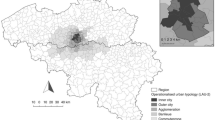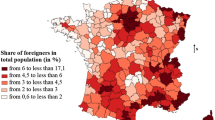Abstract
Many studies have shown that immigrants’ residential situation differs from that of natives and that factors other than housing needs and financial situation influence immigrants’ options and choices concerning housing and neighbourhood. Research has indicated that immigrants might have a stronger preference for renting due to insecurity about their future situation and that especially newly arrived immigrants tend to live in immigrant-dense, so-called multi-ethnic, neighbourhoods. However, the spatial assimilation theory claims that in the course of time immigrants will move to other kinds of housing and neighbourhoods. In this paper, the residential careers of immigrants in the first years after their arrival are examined and compared with Danes. The hypothesis tested is that over time the housing situation of immigrants gets closer to the comparable one for Danes. It is a longitudinal study based on data from 1985 to 2008 on non-Western immigrants in Denmark. The results show that non-Western immigrants steadily increased their presence in social housing and multi-ethnic neighbourhoods during their first 10 years of stay; then, their presence stagnates; and after 15 years, it declines. Part of the initial increase in the frequency of living in multi-ethnic neighbourhoods was not due to individual choices among immigrants but could be ascribed to the increasing number of multi-ethnic neighbourhoods over time. The study confirms spatial assimilation, also when controlling for degree of economic integration, but the change was not dramatic over the 24 years covered by the study.



Similar content being viewed by others
Notes
A Danish survey among moving ethnic minorities by Andersen (2006b) showed that only seven per cent had trouble getting mortgage.
Among refugee countries are chosen: Iraq, Lebanon (Palestinians), Iran, Somalia, Vietnam, Sri Lanka, Afghanistan.
References
Aalbers, M. B. (2002). The neglected evidence of housing market discrimination in the Netherlands. Radical Statistics Journal, 79(80), 161–169.
Alba, R. D., & Logan, J. R. (1992). Assimilation and stratification in the homeownership patterns of racial and ethnic groups. International Migration Review, 26(4), 1314–1341.
Alba, R., & Nee, V. (1997). Rethinking assimilation theory for a new era of immigration. International Migration Review, 31(4).
Andersen, H. S. (2006a). Etniske minoriteters flytninger og boligvalg. Hørsholm: Danish Building Research Institute.
Andersen, H. S. (2006b). Bo sammen eller spredt? Etniske minoriteters boligønsker og motiver for bosætning. Hørsholm: Danish Building Research Institute.
Andersen, H. S. (2010). Spatial assimilation in Denmark. Why do immigrants move to and from multi-ethnic neighbourhoods? Housing Studies, 25(3), 281–300.
Andersen, H. S. (2015a). Indvandring, integration og etnisk segregation. Udviklingen i indvandrernes bosætning siden 1985. Copenhagen: Danish Building Research Institute.
Andersen, H. S. (2015b). Explanations for special neighbourhood preferences among ethnic minorities. Housing, Theory and society (E-pub ahead of print).
Andersen, H. S., Andersson, R., Wessel, T., & Vilkama, K. (2015). Housing systems and ethnic spatial segregation: Comparing the capital cities of four Nordic Welfare States. International Journal of Housing Policy (Forthcoming).
Andersen, H. S., Turner, L. M., & Søholt, S. (2013). The special importance of housing policy for the housing situation of ethnic minorities. Evidence from a comparison of four Nordic Countries. International Journal of Housing Policy, 131, 20–44.
Andersson, R. (1998). Socio-spatial dynamics: Ethnic divisions of mobility and housing in post-Palme Sweden. Urban Studies, 35(3), 397–428.
Arbaci, S. (2007). Ethnic Segregation. Housing systems and Welfare Regimes in Europe. International Journal of Housing Policy, 7(4), 401–433.
Artle, R., & Varaiya, P. (1978). Life cycle consumption and homeownership. Journal of Economic Theory, 18, 38–58.
Bolt, G., Ozuekren, A. S., & Phillips, D. (2010a). Linking integration and residential segregation. Journal of Ethnic and Migration Studies, 36(2), 169–186.
Bolt, G., Phillips, D., & Van Kempen, R. (2010b). Housing policy, (de)segregation and social mixing: An international perspective. Housing Studies, 25(2), 129–135.
Bolt, G., & van Kempen, R. (2010). Ethnic segregation and residential mobility: Relocations of minority ethnic groups in the Netherlands. Journal of Ethnic and Migration Studies, 36(2), 333–354.
Bolt, G., Van Kempen, R., & Van Ham, M. (2008). Minority ethnic groups in the Dutch housing market: Spatial segregation. Relocation Dynamics and Housing Policy, Urban Studies, 45(7), 1359–1384.
Borjas, G. J. (2002). Homeownership in the immigrant population. Journal of Urban Economics, 52, 448–476.
Bråmå, Å. (2006). ‘White Flight’? The production and reproduction of immigrant concentration areas in Swedish cities, 1990–2000. Urban Studies 2006, 43, 1127–1146.
Carliner, G. (1974). Determinants of homeownership. Land Economics, 5, 109–119.
Clark, W. A. V. (1992). Residential preferences and residential choices in a multi-ethnic context. Demography, 29, 451–466.
Conzen, K., Gerber, D., Morawska, E., Pozzetta, G., & Vecoli, R. (1992). The invention of ethnicity: A perspective from the U.S.A. Journal of American Ethnic History, 12, 3–41.
Damm, A. P., Schultz-Nielsen, M. L., & Tranæs, T. (2006). En befolkning deler sig op?. Copenhagen: Gyldendal.
Ersanilli, E., & Koopmans, R. (2010). Rewarding integration? Citizenship regulations and the socio-cultural integration of immigrants in the Netherlands, France and Germany. Journal of Ethnic and Migration Studies, 36(5), 773–791.
Finney, N. (2002). Ethnic group population change and interaction: A demographic perspective on ethnic geographies. Ethnicity and integration. Understanding Population Trends and Processes, 3, 27–45.
Fong, E., & Chan, E. (2010). The effect of economic standing, individual preferences, and co-ethnic resources on immigrant residential clustering. International Migration Review, 44(1), 111–141.
Glazer, N., & Moynihan, D. P. (1970). Beyond the melting pot: The Negroes, Puerto Ricans, Jews, Italians, and Irish of New York City. 1963. Reprint. Cambridge, MA: MIT Press.
Gordon, M. (1964). Assimilation in American life. New York: Oxford University Press.
Greenman, E., & Xie, Y. (2008). Is assimilation theory dead? The effect of assimilation on adolescent well-being. Social Science Research, 37, 109–137.
Johnston, R., Forrest, J., & Poulsen, M. (2002). Are there ethnic enclaves in English Cities? Urban Studies, 39, 591–618.
Kalter, F., & Granato, N. (2001). Recent trends of assimilation in Germany. Fakultät für sozialwissenschaften ZUMA. Universitaet Mannheim.
Kauppinen, T., Andersen, H. S., & Hedman, L. (2010). Determinants of immigrants’ entry to homeownership in three Nordic capital city regions. Paper for ENHR conference 2012 Toulouse.
Luthra, R. R. (2009). Assimilation in a new context: Second generation educational attainment in Germany. California Center for Population Research On-Line Working Paper Series.
Massey, D. S. (1985). Ethnic residential segregation: A theoretical synthesis and empirical review. Sociology and Social Research, 69, 315–350.
Massey, D. S., & Denton, N. A. (1985). Spatial assimilation as a socioeconomic outcome. American Sociological Review, 50(1), 94–106.
Model, S. (1991). Caribbean immigrants: A black success story? International Migration Review, 25, 248–276.
Murdie, R. A. (2002). The housing careers of Polish and Somali newcomers in Toronto’s rental market. Housing Studies, 17(3), 423–443.
Murdie, R. A., & Ghosh, S. (2010). Does spatial concentration always mean a lack of integration? Exploring ethnic concentration and integration in Toronto. Journal of Ethnic and Migration Studies, 36(2), 293–311.
Musterd, S. (2005). Social and ethnic segregation in Europe: Levels, causes and effects. Journal of Urban Affairs, 27(3), 331–348.
Musterd, S., Ostendorf, W., & Breebaart, M. (1998). Multi-ethnic metropolis: Patterns and policies. Dordrecht: Kluwer.
Nielsen, R. S., Holmquist, E., Dhalmann, H., & Søholst, S. (2014). Comparing Somalis’ perceived possibilities in the Nordic capital housing markets: Local context and cultural background. Housing Studies, 30(3), 433–452.
Özüekren, A. S., & van Kempen, R. (2002). Housing careers of minority ethnic groups: Experiences, explanations and prospects. Housing Studies, 17(3), 365–379.
Park, R. E., & Burgess, E. (1969). Introduction to the science of sociology. 1921. Reprint. Chicago: University of Chicago Press.
Peach, C. (1998). South Asian and Caribbean ethnic minority housing choice in Britain. Urban Studies, 35(10), 1657–1680.
Portes, A., & Bach, R. L. (1985). Latin journey: Cuban and Mexican Immigrants in the United States. Los Angeles, CA: University of California.
Portes, A., & Rumbaut, R. G. (Eds.). (2001). Legacies: The story of the immigrant second generation. Berkeley, CA: University of California Press.
Portes, A., & Zhou, M. (1993). The new second generation: Segmented assimilation and its variants. Annals of the American Academy of Political and Social Science, 530, 74–97.
Quillian, L. (2002). Why is black–white residential segregation so persistent? Evidence on three theories from migration data. Social Science Research, 31, 197–202.
Safi, M. (2008). The immigrant integration process in France: Inequalities and segmentation. Revue Française de Sociologie 2008/5, 49, 3–44.
Schaake, K., Burgers, J., & Mulder, C. H. (2014). Ethnicity, education and income, and residential mobility between neighbourhoods. Journal of Ethnic and Migration Studies, 40(4), 512–527.
Schaeffer, P. V., & Bukenya, J. O. (2010). Assimilation of foreigners in former West Germany. International Migration Early View. Article first published online: 15 APR 2010.
Sinning, M. (2010). Homeownership and economic performance of immigrants in Germany. Urban Studies 2010, 47, 387.
Slack, T., & Jensen, L. (2007). Underemployment across immigrant generations. Social Science Research, 36(2007), 1415–1430.
Søholt, S. (2007). Gjennom nåløyet—en sammenligning av tilpasninger til boligmarkedet blant hushold av pakistansk, tamilsk og somalisk bakgrunn, Oslo 1970 – 2003 (Through the eye of a needle—a comparison of adaptions to the housing market among households with Pakistani, Tamil and Somali background, Oslo 1970 – 2003). Thesis. Oslo: Institute for Political Science, Faculty of Social Sciences, University of Oslo.
Søholt, S., & Astrup, K. (2009). Etniske minoriteter og forskjellsbehandling i leiemarkedet (Ethnic minorities and unequal treatment in the rental market). NIBR-report: 2. Oslo: Norwegian Institute for Urban and Regional Research.
South, S. J., Crowder, K., & Chavez, E. (2005). Migration and spatial assimilation among U.S. Latinos: Classical versus segmented trajectories. Demography, 42(3), 497–521.
Valdez, Z. (2006). Segmented assimilation among Mexicans in the Southwest. Sociological Quarterly, 47(3), 397–424.
van Kempen, R. (2003). Segregation and housing conditions of immigrants in Western European Cities. Eurex Lecture 7. 13 March. http://www.shiva.uniurb.it/eurex/syllabus/lecture7/Lecture7-VanKempen.pdf.
van Kempen, R., & Özuekren, A. S. (1998). Ethnic segregation in cities: New forms and explanations in a dynamic world. Urban Studies, 35, 1631–1653.
Wright, R., Ellis, M., & Parks, V. (2005). Re-placing whiteness in spatial assimilation research. City and Community, 5(2), 111–135.
Acknowledgments
This paper was produced as part of the NODES project financed by NORFACE.
Author information
Authors and Affiliations
Corresponding author
Rights and permissions
About this article
Cite this article
Andersen, H.S. Spatial assimilation? The development in immigrants’ residential career with duration of stay in Denmark. J Hous and the Built Environ 31, 297–320 (2016). https://doi.org/10.1007/s10901-015-9459-0
Received:
Accepted:
Published:
Issue Date:
DOI: https://doi.org/10.1007/s10901-015-9459-0




